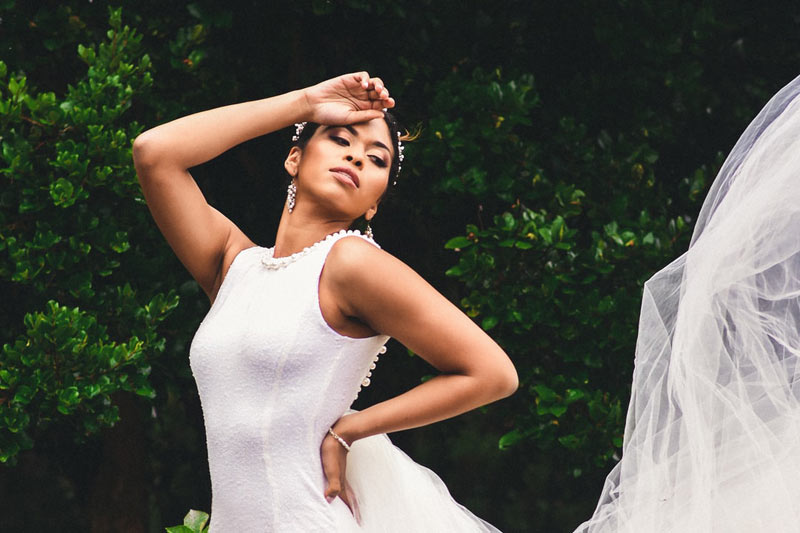Did you know that the color white used to be associated with mourning in the 18th and 19th centuries? Since people commonly wore white to funerals and other sad events, brides didn’t usually wear that color to their weddings. However, Mary Queen of Scots made a bold statement in 1558 by choosing to wear white for her wedding.
Many wedding trends include incorporating color in unexpected ways on a bride’s wedding day. While white remains a popular choice for the hue of wedding dresses, it’s not suitable for everyone. Some brides are even opting to wear black dresses for their big day.
If you’re preparing for your wedding day and want to learn more about white wedding dresses, you’re in the right place. This guide will discuss the history of the wedding dress and whether or not the bride’s dress is required to be white.
What’s the History Behind White Wedding Dresses?
While Mary Queen of Scots was the first well-known bride to wear a white dress on her wedding day, she wasn’t the first. Phillipa of England was the first princess to wear a white gown on her wedding day in 1406.
In addition to being associated with mourning, a white dress was a significant indicator of a bride’s social standing. That’s because the white fabric was difficult to maintain and bleach. A bride would typically wear her wedding dress once if it were white.
Queen Victoria, known for her bold fashion choices, wore white to her wedding to Albert of Saxe-Coburg in 1850. Her wedding photos were widely circulated, influencing many brides in England and Europe.
Brides in the United States weren’t as influenced by fashion trends in Europe. It wasn’t until after the Civil War that brides looked to Britain and Europe for wedding trends. Many American brides wanted to emulate British aristocracy in their gowns for their big day.
At that time, the white fabric was still hard to come by. Many brides who wore white on their wedding day would dye their gown to wear their dress again after that day.
White dresses started increasing in popularity in the 20th due to advancements in the garment industry. White fabrics became more accessible and affordable.
What Does the Color White Mean?
White wedding dresses were often associated with innocence, virginity, luck, and happiness in the past. In modern times, wearing white at a wedding has eliminated those connotations. White has become a traditional color of wedding dresses but not a requirement.
Common Alternatives to White Wedding Dresses
While floor-length white dresses are standard for Western weddings, they’re not the only option brides have. Pink-colored gowns have become a common wedding trend over the past ten years. They’re an excellent option for a bride looking for a feminine color.
Champagned-colored gowns are considered a dark cream color. The color evokes a celebratory yet formal tone. It’s a subtle tweak over a white wedding dress.
Blush is another common color chosen by brides. Blush can complement a lot of different skin tones.
A common wedding tradition in Asian culture is to wear a red wedding dress, but it includes different symbolic meanings. In Chinese culture, red symbolizes luck, happiness, and good fortune. In Western culture, red is the color of courage, power, and passion.
You might want to explore a red wedding dress if you’re an adventurous bride. Red compliments light skin tone and come in a variety of styles.
Blue isn’t always a go-to color choice for wedding dresses, even if having something blue is a wedding tradition. Blue was the symbol of purity before brides began wearing white wedding dresses.
Pale and light blue dresses are an excellent choice for seaside weddings. That’s because they reflect the color of the sky and sea.
The Black Wedding Dress Trend
While black wedding dresses are among the top 2022 wedding trends, brides have been wearing black for decades. Sarah Jessica Parker wore a black dress when she married Matthew Broderick in 1997. Actress Chloe Sevigny wore black for her wedding in 2020.
Even though they’re increasing in popularity, black wedding dresses still aren’t mainstream. Many wedding dress designers don’t regularly carry them in stock, so you might have to seek an independent designer if you want to go for a bold look.
Frequently Asked Questions About White Wedding Dresses
Are you still curious about white wedding dresses? Let’s go over some of the most commonly asked questions on the topic.
Do I Have to Wear a White Dress?
The color of the dress you wear on your wedding day is entirely your choice. Whether you decide to wear white or emerald green, the dress you choose should embody your personality.
Can I Only Wear White to My First Wedding?
Your bridal attire should be whatever makes you feel the most comfortable and beautiful. A common misconception is that brides can only wear white to their first wedding. If it’s your first wedding or your seventh, you can wear whatever color you want.
Does My Reception Dress Have to Be White?
If you decide to wear a second dress to your reception, brides usually opt for something easier to dance in and less formal. Like with your wedding dress, there are no rules for the color. Wear something celebratory and fun.
Can Guests Wear White?
Another common wedding tradition is that no one can wear white to the wedding besides the bride. However, white bridal party and bridesmaid dresses are becoming more popular. If you’re a guest at someone else’s wedding, it’s probably best to avoid wearing that hue.
Learn More About 2022 Wedding Trends
Despite white being a traditional choice for wedding dresses, you should wear whatever color and style of gown you would like on your wedding day. It’s your big day, so you should be comfortable. Don’t let other people’s expectations get in the way of feeling and looking your best.
Do you want to learn more about wedding events and upcoming wedding trends? Check out one of our other blogs for more ideas.
Wedding Details is your comprehensive guide to all aspects of your wedding. From traditional ceremonies to questions regarding the guests, our website offers you one place to do all your research.

